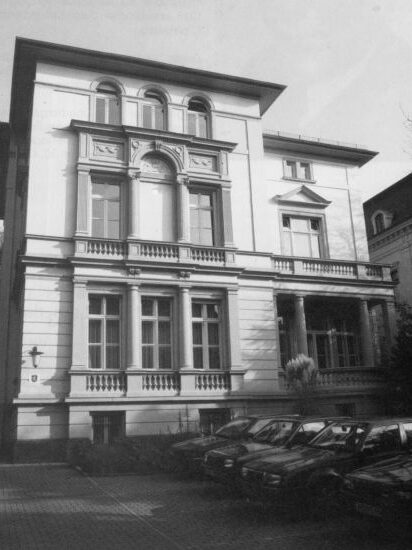Mining authority
Wiesbaden became the seat of a Nassau mining administration in 1744, a Prussian one in 1867 and the Hessian mining administration in 1945.
In the Middle Ages, the right to the valuable mineral resources (minerals), which were therefore excluded from land ownership, belonged to the German king, hence the name Bergregal. After it was transferred to the electors by the Golden Bull in 1356 and to all sovereigns in the Peace of Westphalia in 1648, each sovereign required a specialized administration to exercise the mining rights within its borders. This mining authority managed the state's own mining operations, granted third parties the right to prospect for and extract the mineral resources belonging to the Bergregal against payment of tithes and supervised private mining. Since Wiesbaden became the capital of the Principality of Nassau-Usingen in 1744, the mining and metallurgical administration was also located here as part of the state government. When Wiesbaden became the capital of the Duchy of Nassau in 1806, its responsibilities increased accordingly.
The Nassau mining authority worked in two stages. While the mining licenses, known as "Belehnung" in Nassau, were issued by a chamber of the state government in Wiesbaden, the local mining authority was responsible for the prospecting permit that preceded the license and the mutung required after the discovery to prove that the mine was ready for licensing. Until 1857, this was the mining master's office of Diez for the city area of Wiesbaden; from 1858, Wiesbaden had its own mining master's office. After Nassau became part of the Kingdom of Prussia in 1866, it became the Prussian mining district office of Wiesbaden. After the Koblenz and Wiesbaden mining districts were merged, Koblenz became the seat of the lower mining authority responsible for Wiesbaden in 1893. The right to grant mining rights was transferred from the state government in Wiesbaden to the Prussian Mining Office in Bonn in 1867.
After the end of the Second World War with the formation of the democratic new state of Hesse with its capital Wiesbaden in 1945, the Hessian Ministry of Economics in Wiesbaden became the state's supreme mining authority, headed by a mining captain as head of the mining department. In 1949, the Hessian Mining Authority was founded in Wiesbaden with the mining governor as its head in order to relieve the Ministry of technical administrative tasks such as issuing mining ordinances, mining licenses and mining authority supervision. The mining districts had already been reorganized in 1946 in relation to the territory of the new state of Hesse. Of the four mining authorities that existed in Hesse until 1964, and only three from 1965 onwards, the Weilburg Mining Authority was responsible for the city of Wiesbaden until 1997. The function of the highest mining authority in Hesse was transferred from the Ministry of Economics to the Ministry of the Environment in 1985.
Since October 1, 1997, the mining authority in Hesse has once again been divided into two levels. The Hessian Ministry of the Environment in Wiesbaden remains the supreme mining authority with a specialist department responsible for mining, while the tasks previously the responsibility of the Chief Mining Authority and the subordinate mining offices, in particular for the implementation of the Federal Mining Act, are now carried out by mining supervision departments in a State Environmental Office of each regional council. The Mining Supervision Department responsible for the administrative district of Darmstadt and therefore also for the city of Wiesbaden is based in the Wiesbaden State Environmental Office of the Darmstadt Regional Council in Wiesbaden.
Literature
- Hessisches Oberbergamt (Hrsg.)
Mining authorities and mining in Hesse, Wiesbaden 1995.
- Schade, Hartmut
Wiesbaden and the mining industry. In: Yearbooks of the Nassauischer Verein für Naturkunde 133, Nassauischer Verein für Naturkunde (ed.), Wiesbaden 2012 (pp. 89 - 107).
